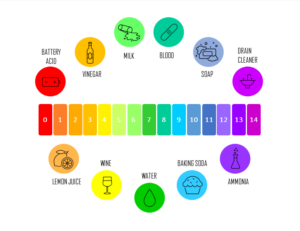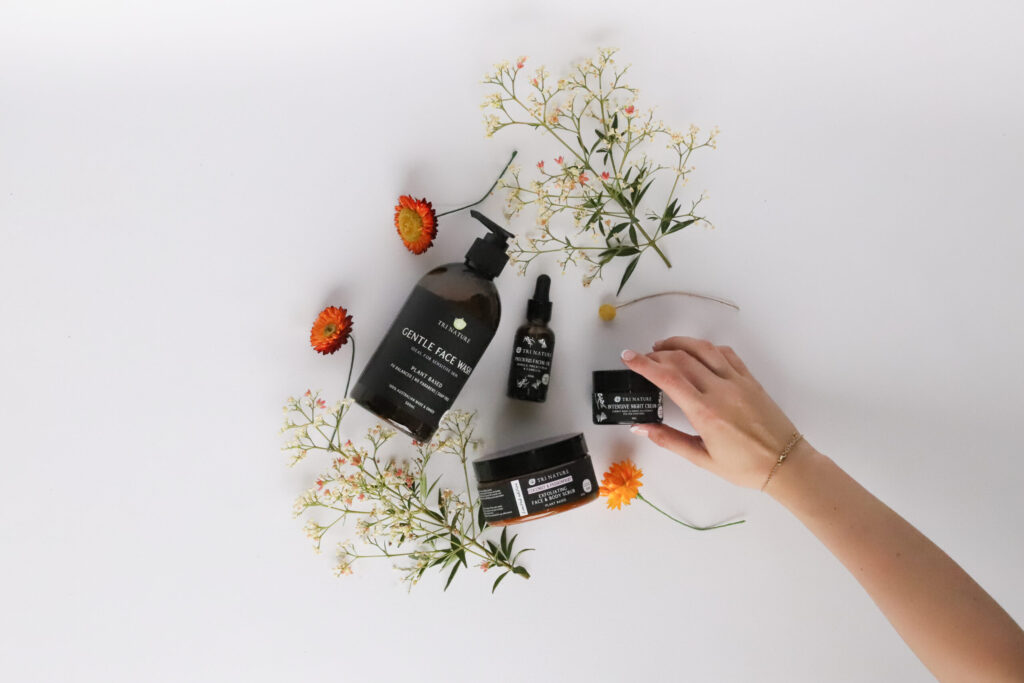You have probably seen the words “pH balanced” on our products but what does it mean and why does it matter. pH is measured on a scale of 0 to 14 with water being neutral (neither acidic or alkaline) in the middle at pH 7. Acidic things have a pH value less than 7 and alkaline things have a pH greater than 7.
What is pH?
(Warning – Get ready to revise some high school chemistry)
pH is defined as the negative log of the concentration of Hydrogen ions (H+) in a water-based (aqueous) solution and is represented by the equation:
![]()
Just kidding! You don’t really need to know that and to put it simply pH is just a measure of how acidic or alkaline something is.
pH is measured on a scale of 0 to 14 with water being neutral (neither acidic or alkaline) in the middle at pH 7. Acidic things have a pH value less than 7 and alkaline things have a pH greater than 7.
To give you an idea of how it works here are the pH values of some everyday items.
- Battery Acid pH ~1
- Lemon Juice pH 2 – 3
- Vinegar pH 2 – 3
- Wine pH 3 – 4
- Milk pH 6.5 – 6.7
- Pure Water pH 7
- Blood pH 7.4
- Baking Soda pH 9
- Soap pH 9 – 10
- Ammonia pH 11
- Drain Cleaner pH 12 – 14
Liquids that do not contain water (e.g. olive oil or petrol) do not have a pH value as pH is only for aqueous solutions.

The pH of skin
Human skin is made up of three layers (epidermis, dermis and hypodermis) and contains water, proteins, fats and minerals. The outer most layer of the epidermis is called the stratum corneum and contains the skin’s protective ‘acid mantle’ and lipid barrier. The surface pH of this layer can be measured and has been found to be mildly acidic.
The pH of the skin has been studied for almost 100 years and it was originally thought to be between pH 5.4 and 5.9 but further studies show it has a wider range of values typically from 4 to 6 (with an average of 4.7) and this can vary depending on the area of the body1.
When babies are born the pH of their skin is higher and close to neutral. After around 4 weeks as the skin matures the pH decreases to the same acidic values as adults. The pH of skin also changes when we become older, and the skin’s pH has been found to be higher in elderly skin1.
Why is skin pH important?
The acid mantle forms part of the skin’s natural barrier and protective functions. It is important to maintain the pH of the acid mantle so that the skin can maintain its barrier and biological functions. The pH of the skin also influences the bacterial flora and other microorganisms that are part of the skin’s microbiome.
If the skin pH is not maintained it can lead to dryness, flakiness, irritation and sensitivity and according to the Clevland Clinic a disrupted skin pH is associated with chronic conditions such as eczema, acne, psoriasis and rosacea1.
Do cleansers affect the skin pH?
Every time we wash our skin (even with just tap water2) we disrupt the skin’s acid mantle but thankfully over time, the skin through a process known as buffering returns the pH to its preferred level.
Different types of cleansers have different pH values and affect the skin’s pH to different extents.
Saponified soaps often referred to as natural soaps (made with oils and sodium hydroxide) have a high pH value (around 9 to 10) and significantly increase the pH of the skin. It takes several hours after cleansing with soap for the skin to return to its preferred pH. If you are frequently washing with soap your skin will not have a chance to recover between washings.
pH balanced cleansers (i.e. cleansers that are balanced to have a pH that is close to the pH of the skin) are generally made with cleansers known as surfactants. These pH balanced products also alter the skin’s pH but to a lesser extent and with a shorter recovery period1.
Although soap can be used by some people without issue, pH balanced cleansers are the preferred option for everyone, especially those with sensitive skin as they are gentler and allow the skin to recover quickly.
Tri Nature’s pH balanced cleansing products are soap-free and made with gentle plant-based cleansers to help maintain the skin’s delicate balance.
What about moisturisers?
Just like cleansers, moisturisers can also alter the skin’s pH but unlike cleansers, most moisturisers generally have a pH that is close to the skin’s natural pH. There are exceptions so it is always best to check that the products you use are pH balanced like Tri Nature’s moisturisers and lotions.
Find Tri Nature’s range of pH balanced personal care products here.
[1] https://www.mdpi.com/2079-9284/8/3/69 [2] https://health.clevelandclinic.org/what-is-skin-ph [3]https://www.researchgate.net/publication/13823408_Effects_of_Soap_and_Detergents_on_Skin_Surface_pH_Stratum_corneum_Hydration_and_Fat_Content_in_Infants


